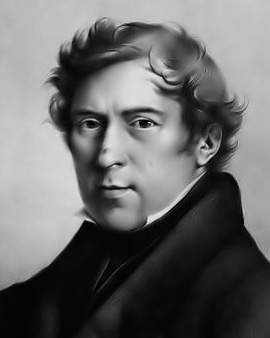The Dutchman Andreas Schelfhout was a talented painter who received international recognition for his landscape paintings. He began his artistic education at the age of 24 as a student of the theatre painter Johannes Breckenheijmer. Relatively quickly Schelfhout discovered his passion and talent for landscape painting. He spent every free minute out in nature, capturing impressions of the diverse landscapes around him in his sketchbook. He already conceived the entire composition of the later painting directly on site in his sketchbook. In his young years he became internationally known. With one of his winter scenes he made his international breakthrough at the age of 28. His winter landscape motifs let the viewers' gaze drift into the distance. Details such as groups of houses, people on skates or city walls create a realistic picture atmosphere. The special thing about his winter landscapes is the individual lighting mood. For his works Andreas Schelfhout received the medal of the Royal Society of Antwerp in 1819. The painting "Winter View with Walkers on the Ice" received several awards four years later.
His early works of art were still clearly oriented towards the style of old masters. But Andreas Schelfhout did not need long to find his own artistic style. Among his favourite motifs were landscapes of his homeland and winter scenes. The snow-covered winter landscapes emanate a special tranquility. Many of his works are kept in a smaller format. Schelfhout began to pass on his own knowledge in the course of his artistic career. He trained numerous students in his artist workshop, including Johan Barthold Jongkind. He was later considered, together with the French artistEugene Boudin, to be an important pioneer of Impressionism. After an eventful life and a period of intense artistic creation, Andreas Schelfhout died at the age of 83 in The Hague. He produced a total of almost 1,200 works. Anyone wishing to admire the originals by the Dutch artist should visit the Fodor Museum in Amsterdam and museums in Haarlem, Rotterdam, Enschede and Ghent. During Schelfhout's lifetime, the atmospheric landscape paintings inspired private individuals, well-known public figures such as Wilhelm II, as well as collectors and art connoisseurs. The works achieved considerable prices. Despite their success, the paintings experienced good and bad times on the later art market. Directly after his death, some of his works were almost given away at auctions. At the beginning of the 20th century the paintings were almost completely ignored by museums and art scientific institutions. The fame and recognition from his lifetime as an artist were almost forgotten during this time. From the 1920s onwards, Schelfhouts landscape paintings were rediscovered and received more attention. Prices at art auctions rose again. Today the painter's well-known landscape paintings are priced in the five-digit range. Those who appreciate the atmospheric landscape paintings of the Dutch artist do not have to invest in an original. With a high-quality art print you can bring the flair of the original into your living rooms.
×





.jpg)
.jpg)
.jpg)
.jpg)
.jpg)
.jpg)
.jpg)
.jpg)
.jpg)
.jpg)
.jpg)
.jpg)
.jpg)
.jpg)
.jpg)
.jpg)
.jpg)
.jpg)
.jpg)
.jpg)
.jpg)
.jpg)
.jpg)
.jpg)
.jpg)
.jpg)
.jpg)
.jpg)
.jpg)
.jpg)
_-_(MeisterDrucke-1315190).jpg)
_-_(MeisterDrucke-1315190).jpg)
.jpg)
.jpg)
.jpg)
.jpg)
.jpg)
.jpg)
.jpg)
.jpg)
.jpg)
.jpg)
.jpg)
.jpg)
.jpg)
.jpg)
.jpg)
.jpg)
.jpg)
.jpg)
.jpg)
.jpg)
.jpg)
.jpg)
.jpg)
.jpg)
.jpg)
.jpg)
.jpg)
.jpg)
.jpg)
.jpg)
.jpg)
.jpg)
.jpg)
.jpg)
.jpg)
.jpg)
.jpg)
.jpg)
.jpg)
.jpg)
.jpg)
.jpg)
.jpg)
.jpg)
.jpg)
.jpg)
.jpg)
.jpg)
.jpg)
.jpg)
.jpg)
.jpg)
.jpg)
.jpg)
.jpg)
.jpg)
.jpg)
.jpg)
.jpg)
.jpg)
.jpg)
.jpg)
.jpg)
.jpg)
.jpg)
.jpg)
.jpg)
.jpg)
.jpg)
.jpg)
.jpg)
.jpg)
.jpg)
.jpg)
.jpg)
.jpg)
.jpg)
.jpg)
.jpg)
.jpg)
.jpg)
.jpg)
.jpg)
.jpg)
.jpg)
.jpg)
.jpg)
.jpg)
_Peinture_dAndreas_Schelfhout_(1787-1870)_Huile_su_-_(MeisterDrucke-1318832).jpg)
_Peinture_dAndreas_Schelfhout_(1787-1870)_Huile_su_-_(MeisterDrucke-1318832).jpg)
.jpg)
.jpg)
.jpg)
.jpg)
.jpg)
.jpg)
.jpg)
.jpg)
.jpg)
.jpg)
.jpg)
.jpg)
.jpg)
.jpg)
.jpg)
.jpg)
.jpg)
.jpg)
.jpg)
.jpg)
.jpg)
.jpg)
_-_(MeisterDrucke-910110).jpg)
_-_(MeisterDrucke-910110).jpg)
_-_(MeisterDrucke-1102556).jpg)
_-_(MeisterDrucke-1102556).jpg)
.jpg)
.jpg)
.jpg)
.jpg)
.jpg)
.jpg)
.jpg)
.jpg)
.jpg)
.jpg)
.jpg)
.jpg)
.jpg)
.jpg)
.jpg)
.jpg)
.jpg)
.jpg)
.jpg)
.jpg)






